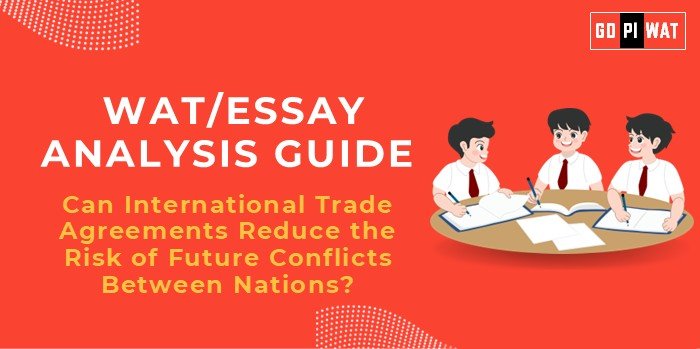📋 Written Ability Test (WAT)/Essay Analysis Guide
🌍 Topic: Can International Trade Agreements Reduce the Risk of Future Conflicts Between Nations?
📖 Understanding the Topic’s Importance
💡 Trade agreements are central to global economic stability and diplomacy. For B-schools, understanding these agreements provides insights into market dynamics and geopolitical strategies.
🕒 Effective Planning and Writing
- ⏱️ Time Allocation:
- Planning: 5 minutes
- Writing: 20 minutes
- Review: 5 minutes
- 📚 Preparation Tips:
- Highlight major agreements like RCEP and USMCA.
- Use historical precedents such as the EU’s role in peacekeeping.
✍️ Introduction Techniques for Essays
- ⚖️ Contrast Approach:
“Despite trade fostering collaboration, disputes like U.S.-China tariff wars highlight its limitations in resolving conflicts.”
- 💡 Solution-Based Approach:
“International trade agreements can be redesigned to better address conflict prevention alongside economic goals.”
- 🕰️ Timeline Approach:
“From the Silk Road to the WTO, trade agreements have evolved as tools for stability, yet gaps remain.”
📚 Structuring the Essay Body
- 🏆 Achievements:
- Case Study: The EU as a peace model, fostering collaboration among former adversaries.
- Data: RCEP represents 30% of global GDP, underscoring shared economic interests reducing conflict risks.
- ⚠️ Challenges:
- Example: Brexit’s impact on EU trade relations, highlighting political divides within trade agreements.
- Data: $1 trillion cost due to trade conflicts, according to the World Bank (2022).
- 🌏 Future Outlook:
- Propose inclusive frameworks that address both economic and political conflicts.
- Include conflict mitigation clauses in trade agreements to handle disputes proactively.
🔑 Concluding Effectively
- ⚖️ Balanced Perspective:
“Trade agreements foster peace but need holistic approaches to address non-economic disputes.”
- 🌍 Global Comparison:
“Learning from EU integration and ASEAN’s success could guide future frameworks.”
📊 Analyzing Successes and Shortcomings
- 🏆 Key Achievements:
- Economic interdependence reduces incentives for conflict.
- Enhanced collaboration among nations through shared goals.
- ⚠️ Ongoing Challenges:
- Rising nationalism and protectionist policies hinder trade agreements’ effectiveness.
- Lack of universal enforcement mechanisms weakens global compliance.
- 🌏 Global Context:
- The EU’s success contrasts with Brexit’s divisive fallout.
- ASEAN and RCEP offer lessons in balancing regional priorities with global trade goals.
🌱 Recommendations for Sustainable Progress
- 📜 Prioritize equitable trade practices to ensure all parties benefit fairly.
- 📈 Enhance multilateral enforcement mechanisms for better compliance.
- 🤝 Include conflict resolution clauses in trade agreements to proactively address disputes.
📄 Sample Short Essays
- ⚖️ Balanced Perspective:
“While trade agreements reduce tensions through interdependence, they are no panacea for geopolitical disputes.”
- 💡 Solution-Oriented:
“Integrating conflict-resolution mechanisms in trade agreements could redefine their role in fostering global peace.”
- 🌍 Global Comparison:
“The EU demonstrates trade agreements’ potential to ensure peace, contrasting with challenges faced by ASEAN and RCEP.”


